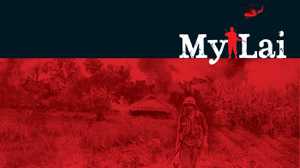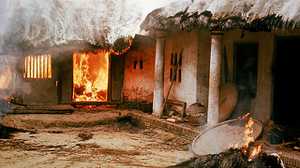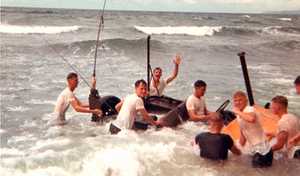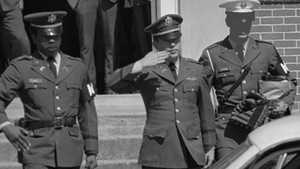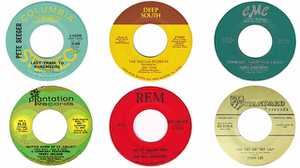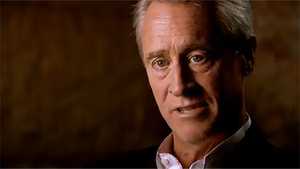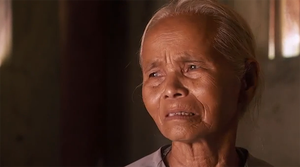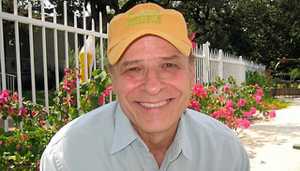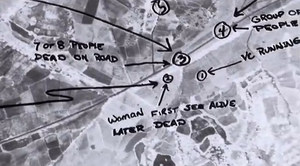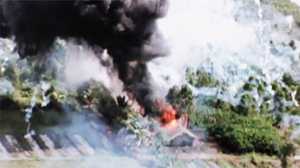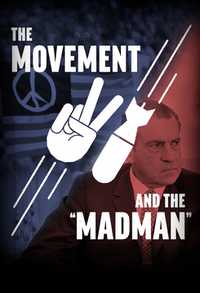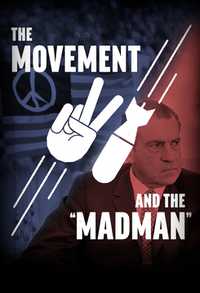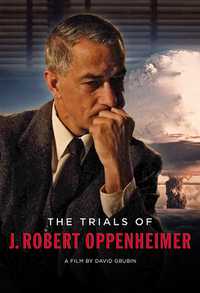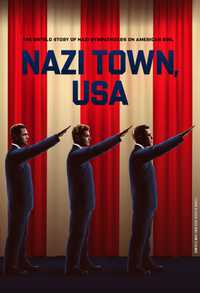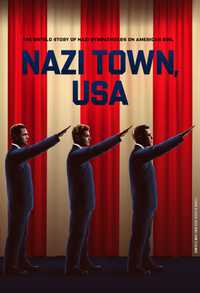Aubrey Daniel, Army Prosecutor: It was the summer of 1969. I was an Army prosecutor at Fort Benning, Georgia. I was sitting in my office, and my supervisor walked in, closed the door, looked at me and said, "Have you ever heard of Pinkville?" And I said, "No, I haven't." And he briefly described what Pinkville was. It was a place on a map of Vietnam, and there had been an operation there.
NBC News Anchor (Archival): Charges have been made that troops killed as many as 567 South Vietnamese civilians during a sweep in March 1968. A lieutenant has been charged with murder and a staff sergeant with assault with intent to murder...
Aubrey Daniel, Army Prosecutor: By that point the Army had conducted an investigation. Quite a record had been established. A lot of people had been interviewed.
Voice of Peers Commission Member (Archival): Did Captain Medina say anything about what the company should do in the village?
Voice of Man Testifying (Archival): He said that there wasn't going to be anything left alive in the village.
Aubrey Daniel, Army Prosecutor: It was clear that many, many people had died. Old men, women with children in their arms, and babies. And they had been unarmed, they had been unresisting, and they had been, in my judgment, massacred.
Voice of Man Testifying (Archival): Lieutenant Calley came back and he said, 'Take care of 'em.' He says, 'I mean, kill 'em.'
Voice of Man Testifying (Archival): When they were all just lined up and shot like that, it sort of reminded me of newsreels of Hitler.
Aubrey Daniel, Army Prosecutor: There certainly appeared that there had been an effort to cover up what happened at My Lai. That seemed to be clear.
Voice of Peers Commission Member (Archival): Did Mr. Thompson mention anything to you about landing alongside of a ditch that contained a large number of bodies?
Voice of Colonel Oran Henderson (Archival): No Sir. He did not report to me any instance of a U.S. soldier firing into a ditch.
Aubrey Daniel, Army Prosecutor: To bring a case like this, given its potential magnitude, it had to be solid. It had to be very strong. It had to be believable. And it had to make believable an event which nobody would ever want to believe. The question was what was the scale that we were dealing with? How big was this and who did it? Who killed these people?
Fred Widmer, Radio Operator: Charlie Company was a cross-section of just your general, basic young people at that point in time. We were from all over the country. You know - East Coast, West Coast, Blacks, Whites, Mexicans - there was nothing special about us. We were just your common, ordinary teen. I'd gone to college for couple semesters after high school. I wasn't cut out for college, I went to be a teacher, and then it was like no, the wrong profession. Having grown up with parents that came from World War II and people that were in the Korean War and everything, being exposed to their generations, yeah, you felt it was basically your duty to go ahead and go to war.
Lawrence La Croix, Squad Leader: My father was a battalion commander in World War II. I considered him kind of a cross between John Wayne and Steve McQueen or something. I did have a notion of what it was going to be like, that it was patriotic, that it was the thing to do.
Greg Olsen, Machine Gunner: I was born in Utah - pretty typical Mormon family. I went into the Army right out of high school.
Walter Cronkite, CBS News Anchor (Archival): In the Vietnam War, U.S. Marines battled North Vietnamese throughout the day...
Greg Olsen, Machine Gunner: Vietnam was all around us. You know, it was in the press and talking about it in school, and we had a real strong curiosity. We wanted to see it for ourselves.
CBS News Reporter (Archival): The artillery is trying to suppress a Communist attack on Baker Company which is about 5,000 meters to our front.
Greg Olsen, Machine Gunner: Aside from just a sense of adventure, I was caught up a little bit in the domino theory that it truly was a necessary war.
John Smail, Squad Leader: You know when I first went, I was into the idea that I was going to free these people and stop Communists from spreading. I didn't go over there to be a hero or nothing. I just went over there to do my job.
Slate: In December 1966, 140 members of Charlie Company began training in Hawaii, under Captain Ernest Medina.
John Smail, Squad Leader: When I first landed in Hawaii, I thought I was in paradise. I mean, 70-some degrees at 3 o'clock in the morning and then they bused us south to Schofield barracks and there's banana trees and everything so I thought it was paradise. It didn't take long for that to end. The East range where we did most of our training, it was straight up and down, and it was a real jungle.
Michael Bilton, Writer: It's quite clear that in Hawaii they excelled themselves in the jungles. Charlie Company was voted the best company in the 1st 20th Battalion. Their captain was almost a folk hero. Medina had come up through the ranks from a Mexican-American background. He related to the men; he was a hard man, he didn't give them an easy time, but they respected him, and many of them loved him.
Fred Widmer, Radio Operator: The motto of the Army is "Follow me," and he was the type of individual you would follow anywhere and do anything for.
Lawrence La Croix, Squad Leader: I found Captain Medina to be a very tough individual, very demanding. He wanted us to be something unique and different, and you know, strong and capable and a force to deal with. Captain Medina came up with the idea that we were going to be called the 'Death Dealers.' He wanted us to carry aces of spades, and every time we killed a Vietcong we were to leave the ace of spades on it so that, you know, they knew that it was from the Death Dealers.
Kenneth Hodges, Squad Leader: Lieutenant Calley was platoon leader of the first platoon. Young lieutenants are not liked very well. Some are quite gung-ho, some are quite interested in making a name for themselves. Calley was sort of a mixture. He wanted to fit in. I think when he found the Military he thought he found his calling, he found a place to fit in.
Thomas Turner, Team Leader: My first impression of Lieutenant Calley was he was always trying to please Captain Medina. He'd go out of his way to do things that were not called for and trying to please Captain Medina and that, to me it made, in my mind, it made Captain Medina resent him even more.
Jerome Walsh, Investigator, Peers Commission: Captain Medina would just call him a little shit or something. I mean, he ridiculed Calley. He made Calley feel inadequate, and Calley was always trying to do things to show that he was a real officer.
Fred Widmer, Radio Operator: By asserting his rank, he basically shielded himself from his men, he isolated himself. Rank went to his head. And that's a no-no.
Slate: On December 3, 1967, Charlie Company arrived in Quang Ngai Province, Vietnam.
Thomas Partsch, Grenadier: For the first month, it was like, "Where's the war?" You know, we had a lot of free time. The lounges, you know, the bars, it was really nice. We said, "Hey, I could do this for a year." We'd walk through the villages - mostly women, children, older people - we really didn't encounter anything where we went. It didn't seem like there was a war going on over there!
Fred Widmer, Radio Operator: You would go to a village, set up a perimeter. Medics and doctors would come in, treat the civilians and we'd sit there and play with the kids. And there was nothing else to do. We always had fun with the kids.
Do Ba, My Lai Villager: When I was young, I saw American soldiers. Whenever they came, they would gather up everyone. They would bring cake and candy for the children. Everyone would have some and then they would let us go home.
Ha Thi Quy, My Lai Villager: I never would have imagined, never would have thought Americans would kill us. When my children came home and asked if American soldiers were killers, I said, "No. Americans don't kill."
Slate: Two months after arriving in Vietnam, Charlie Company was detailed to Task Force Barker.
Michael Bilton, Writer: Task Force Barker was set up around February. Its real function was to try and break the infrastructure of the North Vietnamese Army and the Viet Cong in that central plain of Quang Ngai Province.
Greg Olsen, Machine Gunner: Quang Ngai province had a reputation for 300 years for hating foreign occupying forces whether they were Chinese, French, Japanese, or Americans. They just did not like strangers coming in among them and then exercising military power.
Jonathan Schell, Writer: Great areas of the province had been declared Free Fire Zones. What that meant was you just kept up a constant round of the bombing of villages. The U.S. Military loved to quote from Mao Zedong, especially, the saying that 'the guerillas are the fish and the people are the sea.' But the solution to that problem was to drain the sea.
Tim O'Brien, Writer: Bullets can kill the enemy but bullets can also make an enemy - they can manufacture an enemy. And I felt at times during my stay there that we were cranking out enemy soldiers or sympathizers by the way we treated the place.
James S. Olson, Historian: Soldiers had thought they were gonna go in there and be welcomed by the people whom they were going to save. Some of them thought it was going to be like going into Paris after D-Day. What they encountered instead was hostility, out right hostility and resentment from these people.
Pham Thanh Cong, My Lai Villager: When I was eight years-old, I realized the war had come. There were many times when the American soldiers would set up operations around this area and raid and shoot. So my mother brought me and my siblings together and taught us to flee. Every night we had to crawl into the shelter to sleep. We had to avoid the American bombs and shootings. That was our misery. War from the Americans.
Fred Widmer, Radio Operator: We started pulling regular patrols end of January, beginning of February. Once we started down in the Pinkville area, we started losing people. They were they were being picked off one by one. This is when we got our initiation into the realities of Vietnam with booby traps, mines, snipers.
Tim O'Brien, Writer: The Quang Ngai area was called Pinkville because on the military maps it was shaded a bright kind of shimmering pink. The color pink took on associations for us that went way beyond anything you'll find on some color chart. It meant the prospect of death.
Fred Widmer, Radio Operator: Weber was the first member that we lost. That had a real impact on the whole company, because we actually had somebody killed now.
Thomas Turner, Team Leader: We were down by a river and walking on the rice paddies, and were we going down to this village that was kinda in the corner of the river and we started taking sniper fire. Lieutenant Calley wanted us to go across the river to where that sniper fire was coming from. Well, we hadn't hardly got started and there was a sniper round and it got Bill Weber. He pretty well died on the scene but not without a lot of anguish.
Joe Grimes, Squad Leader: He was a good guy to everybody, you know, and when he got killed, it's just like part of your family; they destroyed part of your family. But that, I considered Charlie Company part of my family.
Greg Olsen, Machine Gunner: It wasn't long after that we started taking more casualties.
Voice on Radio (Archival): We're in the process of crossing, receiving sporadic sniper fire, over.
Greg Olsen, Machine Gunner: When you're dealing with snipers, it's like a roulette wheel. You know, there's 30 or 40 of us out there walking around. Which one of us is going to get it? You know, you - it's a roll of the dice. And the same thing with the booby-traps.
Philip Caputo, Writer: The infantryman lives on the ground. He walks on the ground, he sleeps on the ground, he eats on the ground. When you've got booby traps and land mines all of a sudden the earth becomes the enemy in a way, because you don't know what it may conceal.
Tim O'Brien, Writer: Where do you sit, and where do you put your feet, there or there? And that choice is life or death.
Army Medic (Archival): ...Speak to me. Speak to me. What's your name, tell me what your name is. Where you from? Seattle, Washington that's a good town. Good town, good town, very good town. Huh? No, don't go to sleep, I don't want you to go to sleep, I don't want you going to sleep at all...
Fred Widmer, Radio Operator: You can't fight, there's nothing to fight. You can't fight a mine. You can't fight a booby trap. You can't fight a sniper. You can try to find that sniper and eliminate him, but they hit and run.
Joe Grimes, Squad Leader: You just wanted to get up and yell, and we did. You know, we yelled, "Come on out," you know, but their snipers were probably over there laughing at us, they wouldn't come out, they wouldn't come out.
Michael Bilton, Writer: This went on for several weeks. They're gradually losing more and more wounded until they came to a minefield.
Kenneth Hodges, Squad Leader: Our second platoon was in one area, and first platoon was ahead of us in another area, but we walked in two minefields almost simultaneously.
Fred Widmer, Radio Operator: Once the first mine was tripped, anybody who moved was setting off booby traps. It was like nonstop. Somebody would go to try to help somebody, that tripped a booby trap, they would hit a booby trap, they'd get blown up.
John Smail, Squad Leader: I could see 'em going off and I could hear people screaming 'medic, medic.' You lay there for a minute then, you know, you gotta get up, you gotta go.
Fred Widmer, Radio Operator: We were a close-knit group. We were there for each other, and that was the problem. Somebody got hurt, you went to help, regardless. You didn't care about the other mines. You went to help somebody. And in the end, it cost more individuals getting hurt.
Thomas Turner, Team Leader: Bobby Wilson was in my squad. We were in single file and there was other guys behind us, and we were walking along and this huge explosion went off and it knocked me to the ground, and Bobby Wilson had tripped a Bouncing Betty. Bobby was pretty well split in half right up the middle and Medina was running through the minefield, barking out orders. He seemed to be fearless.
Voice of Captain Ernest Medina (Archival): He was split as if somebody had taken a cleaver right up from his crotch all the way up to his chest cavity. I've never seen anything that looked so unreal in my entire life. We took a poncho and we spread it out. The medic, started to pick him up by the legs, I reached underneath his arms to place him onto the poncho, we set him on top another mine. My company by this time had suffered approximately 25 to 28 casualties, I was down somewhere to the vicinity of 105 men.
Joe Grimes, Squad Leader: I believe that the month of February was our most devastating month for Charlie Company. It drove us to the ground. It's just like if you had a wound, and they would stick something in that wound and go a little bit deeper. Every time somebody else got killed, and it was like that wound, and it would go a little deeper. And the hurt never stopped.
Fred Widmer, Radio Operator: Your mindset has to change and you've got to somehow figure out how to adapt. Your attitude towards the villagers, now - everybody's an enemy. You don't know who to trust. You don't know who is a friend, who is a foe. You don't have a scorecard to tell you, well, this village over here is friendly to you, it's okay to go there. Or, this village over here is sympathetic to the Communists... and you start to wonder who's who.
Lawrence La Croix, Squad Leader: They know where the mines and booby traps are, they have to or they can't work in the fields, they can't move between villages, you know. So they know where everything is. But they're not gonna tell you. They're gonna let you blow your leg off. You begin to hate and the hatred becomes very intense and very real.
Fred Widmer, Radio Operator: Finally, you just throw the rulebook away. The rules of the game have changed. Instead of just going through villages, casually going through them, you went into villages, started ripping shit apart. That became the standard now - we're not nice guys anymore.
Greg Olsen, Machine Gunner: Individuals would just come out of nowhere and do things you would just find hard to believe, you know. I remember one guy that held a young girl at gunpoint and made her perform oral sex on him. And then, he cut off her ponytail and stuck it in his helmet. And it always mystified me how somebody could walk around with that ponytail and not get questioned about it. I don't think Medina had any interest in knowing all the details of what's going on out there.
Michael Bilton, Writer: If officers and NCOs start behaving badly, then there is absolutely nothing, in a difficult situation, where young men are feeling frightened for their lives, not knowing the difference. They expect to be shown what is right and what is wrong by the officers, by the NCOs, and when that discipline has fallen apart, then they were on the road to hell, frankly.
Greg Olsen, Machine Gunner: Dear Dad, how's everything with you? One of our platoons went on a routine patrol today and came across a 155-millimeter round that was booby-trapped. Killed one man, blew the legs off two others, and injured two more. On their way back to the LZ, they saw a woman working in the fields. They shot and wounded her. Then, they kicked her to death and emptied their magazines into her head. It was murder; I'm ashamed of myself for not trying to do something about it. This isn't the first time, Dad. I've seen it many times before. My faith in my fellow man is all shot to hell. I just want the time to pass, and I just want to come home. Saturday, we're being dropped in by air in an MVA stronghold. Don't expect any letters for a while, but please keep writing them. I love and miss you and Mom.
Michael Bilton, Writer: By the time it got to the fifteenth of March, Charlie Company were pretty well wound up. They were told that there was a very good opportunity the next day that they would meet the enemy head on. There was a lot of talk about a battalion, the 48th VC infantry battalion. They were thought to be a pretty crack outfit, and they were said to be housed in and around the My Lai area. The brigade commander, a man called Colonel Oran Henderson, wanted his battalions to be much more aggressive with the enemy. And it's fair to say Henderson wound up Medina, and Medina wound up Charlie Company.
Voice of Captain Ernest Medina (Archival): I told them this would give them a chance to engage the 48th VC battalion, that the 48th VC Battalion was the one that we had been chasing around the Task Force Barker area of operation, and that we would finally get a chance to destroy the 48th VC Battalion.
Fred Widmer, Radio Operator: Medina was psyched because here's our chance to confront the enemy. We're getting our revenge on you. We're going to tear your ass apart for what you've done to us.
Lawrence La Croix, Squad Leader: We were to shoot literally anything that moved. If it was growing, cut it down. If it was a building, burn it. If it was a well, poison it. If it was alive, kill it.
Greg Olsen, Machine Gunner: I remember him telling us that the villagers have been warned out. There shouldn't be any innocents there and I think there was even questions asked is 'how would we know if they're innocent or not?' He said something to the effect, 'if they're there, you've got to assume they're the enemy.'
Lawrence La Croix, Squad Leader: There were no civilians. You see, that is the crux of what was told to us. There are no civilians, you know, these are Vietcong, Vietcong sympathizers, it's a Vietcong stronghold, they are all Vietcong.
Michael Bilton, Writer: Medina, I believe, was very clear that they were facing the 48th Vietcong infantry battalion. That was the intelligence he had been given, and he had no reason to question it. The problem was that the information was wrong. The 48th infantry battalion were a hundred and fifty miles away, on the other side of Quang Ngai province. And so the entire premise for going to My Lai was entirely false.
Slate: March 16, 1968
Kenneth Hodges, Squad Leader: The morning of the 16th started early. The mood was sort of somber, but there's an edge of excitement; we know that we're going into something big and we're gonna deal with them.
Fred Widmer, Radio Operator: A little fear, anticipation. This was our chance to prove ourselves as a fighting unit.
Kenneth Hodges, Squad Leader: We were instructed to pack a triple basic load of ammunition. Whereas a rifleman would carry 180 rounds, he was to triple that number. So we were expecting great resistance in that village.
Lawrence La Croix, Squad Leader: I would say that probably most of us didn't eat very much. We were all anxious, concerned about what was going to be happening. This was gonna be an all-out war. This was gonna be shades of Iwo Jima.
Michael Bilton, Writer: The helicopters would ferry them in three groups, and drop them in the patty fields, about two-hundred meters from the village - the first group of men would go through led by Calley, the second platoon would come in next, they would follow up with the third platoon and Medina's group. This was the order that came down from on high. They would have to move forward quickly and very aggressively.
Thomas Turner, Team Leader: I was on the lead helicopter; and there's probably 9 helicopters and 6 gunships on the side of us. I remember making the big turn and heading back north straight for My Lai.
Lawrence La Croix, Squad Leader: We began hearing radio chatter that the helicopters were fired on. The helicopter pilot turned to us and told us that we were coming into a hot LZ. The meaning which was quite clear, we were under fire. As we touched down, the door gunners were firing. There were rounds zinging kind of all around. It's hard to tell where they were coming from at that point. We hit the ground and almost immediately started firing into the village area.
Kenneth Hodges, Squad Leader: The squad leaders, myself and others, are instructing their soldiers let's get up on line, let's move it, let's move it, you gotta get in position, we're gonna move out.
Thomas Turner, Team Leader: I remember somebody yelling, 'there's people moving in the village,' and then we could see people running and so we all opened up. I think we had it in our minds that we were not gonna get pinned down out there.
Thomas Partsch, Grenadier: We assumed that we were going to hit VC only, that the civilians would be gone from that entire village. When we went in further, we did start finding people. Like, they started coming out of their house. And we're saying, 'Oh, wait a minute. What the hell is this? They're not supposed to be in here.' At first, nobody did anything. Then, a couple of crazy guys said, 'Hey, they must be VC." Some of the guys started shootin'.
Fred Widmer, Radio Operator: Once the first civilian was killed it was too late, period. Whoever killed the first civilian that was the end of - end of the situation. It went out of control.
Ronald Haeberle, Army Photographer: It was just shoot, shoot, shoot at anything. I don't care what moved. I mean, it's just - the person would come out of a hut. Bang, shoot! It was just complete carnage there that day.
Lawrence La Croix, Squad Leader: We did see bunkers and we did start throwing grenades into the bunkers. It was about that time that we started hearing the screaming from inside.
Pham Thanh Cong, My Lai Villager: Around 8:30, three American soldiers came to my house. They pushed six of us down into the shelter and threw a hand grenade in behind us. And then they used their machine guns to shoot us down. My entire family was blown into pieces. The only person left alive was me.
Tran Nam, My Lai Villager: Suddenly, an American soldier came in carrying a gun. I saw my father collapse, and then my mother, my grandfather, and my grandmother, they all continued to fall. My brother, younger than me, only three years old, suddenly they blasted his head open. One shot and his head blasted onto the floor.
John Smail, Sergeant: We were a unit that was full of anger, frustration. We wanted contact, we wanted to fight the enemy, and we were told we were doing it.
Kenneth Hodges, Squad Leader: I am a soldier and I received and obeyed the orders that were issued to me by my superiors. The order was to kill or destroy everything in the village, the children happened to be there. The people of that village were Vietcong or Vietcong sympathizers. Maybe some see it differently. That's the way I see it.
Ronald Haeberle, Army Photographer: I was the photographer on the operation that day. I just photographed everything that I came upon. I was coming up to a group of people who were huddled and they had some, you know, American GIs surrounding them. One soldier spoke up and said, "Hey! Here's a person with a camera!" And, sure enough, the soldiers backed off and I moved up and I took a photograph of these people. You can see the fear in the faces on there especially the small children, and the older woman trying to protect the daughter. Then, all of a sudden, the next instant, automatic fire. They were all shot. I saw them drop to the ground.
Dan Millians, Helicopter Pilot: As I recall on that particular day, I was flying a gunship, tagging along behind the OH-23 flown by Hugh Thompson. We were told it was a typical combat assault, near an area called Pinkville on the map. It was a strange looking map for that particular area, because it looked like there should be a lot of buildings and everything, but when you get out there it really is not much of anything, just small hamlets scattered about. The OH-23 flown by Hugh Thompson, it had a door gunner on either side, and he would fly low, treetop level, basically, trying to draw fire or make somebody run. It's pretty much a bait-type operation.
Trent Angers, Writer: Hugh Thompson's job was supremely dangerous; the kill rate was something like 40 or 50%. I think that what motivated Hugh to join the Army was just his patriotism, his love for his country. He was a soldier's soldier. He was a, very much of a military mentality. His father was a lifer in the Navy. His brother joined the Air Force and served two or three tours of duty in Vietnam. He also thought that flying a helicopter would be a very exciting profession.
Lawrence Colburn, Helicopter Gunner: The morning of My Lai, Hugh Thompson and I came on station at about 7:30, and it was crystal clear. We came in at altitude and dropped down and started flying low level. We thought that we were really helping the men on the ground and that's, that was our main objective.
Dan Millians, Helicopter Pilot: We came in and strafed the tree lines on either side of the landing zone to suppress anybody that might want to jump up and shoot. We got no fire. We were never fired upon.
Lawrence Colburn, Helicopter Gunner: We started to just check the perimeter. We saw people leaving the area, which was not unusual, it was a Saturday morning, people would go to market on Saturday morning. We thought wonderful, they're getting out of the way let's continue our recon, we were off, or out of that particular area for ten, fifteen, maybe twenty minutes. When we came back, those same people were dead or dying on the road.
Dan Millians, Helicopter Pilot: At some point during the day, we started seeing bodies accumulate in the village. Women, kids - I'd never seen anything like that. It was bad.
Lawrence Colburn, Helicopter Gunner: We lingered by one of the bodies that we marked, it was a young female with a chest wound, but she was still alive. Mr. Thompson decided he'd move back, stay at a hover and watch, and we saw a captain approach the woman, look down at her, kick her with his foot, step back and just blew her away, right in front of us. Later on we found that it was Captain Medina, Ernest Medina who did this.
Lawrence La Croix, Squad Leader: As we got deeper into the village, we were given more or less a change of orders. We were to stop firing and to start moving people that we found over toward the center and pushing them into the center of the village and they were being picked up by Calley's platoon more or less and moved onward.
Truong Tham, My Lai Villager: They start to take us all away. Everyone in the house, they took us to leave, all of us were taken away.
Pham Thi Tuan, My Lai Villager: I held one of my children, and led the other one. I walked with them until they told us to stop. They made us walk from inside the village, across the rice fields. I pulled my kids to go with me. I dragged my kids, but they still hit us, kicked us.
Michael Bilton, Writer: By the time they'd got out to the other side, they'd gathered together about a hundred and seventy old men, elderly women, mothers with small children, and pushing them, herding them, across to the eastern side of the village near to where a big drainage ditch was situated. And they were all standing around on the edge of the ditch and Calley was there with his platoon and Hugh Thompson was flying around in his small, scout helicopter.
Lawrence Colburn, Helicopter Gunner: We continued to recon; checked on some of the people we marked earlier with smoke, they were gone. At that point, Mr. Thompson noticed there was an irrigation ditch that he saw people in, so he landed the aircraft. He approached the soldier that was near the ditch and said, 'These are civilians, we gotta help 'em out," and the soldier said, 'Yeah we'll help 'em out of their misery.' Mr. Thompson went through every scenario he could to give benefit of the doubt to the men on the ground, he did not want to believe that our people were doing this and he came back, got in the aircraft, we lifted off and we were fifteen, twenty feet off the ground and we heard automatic weapons fire.
Michael Bilton, Writer: Suddenly, Calley gave the order to start firing, and Calley and a young man called Meadlo turn their rifles, their M16 rifles on this group and began shooting. Mothers started diving with their children into the ditch. One mother described it later as like ducks, going into the water.
Voice of Paul Meadlo (Archival): Lieutenant Calley told me, "Meadlo, we got another job to do." And so, we started pushing them off and we started shooting them. So then all together we just pushed them all off and just started using automatics on them.
Greg Olsen, Machine Gunner: It didn't surprise me that Paul Meadlo was one of the participants with Calley in shooting down that group of people. Paul, did have a strong sense of duty. He just did what he was told. I've thought about what I would have done many times, if Calley would have put me in the position he did Paul and I would like to think I would have just said, "You got to be kidding me," and walked away and taken my chances that he wouldn't have shot me. I don't think I could have done it. I just really don't think I could have done it.
Thomas Turner, Team Leader: Calley yelled at me to come help him and I just kept walking; I didn't even turn around and answer him. And I thought at the time, "Well, that's disobeying an order, he can do anything he wants to me.' But I didn't care. I wasn't gonna help him kill people in a ditch. To this day, I always think to myself what could I have done to stop it and I don't know the answer to that.
Do Ba, My Lai Villager: They started to push all the people down into the ditch, including my family. And they started shooting at will. After the first round, my mother and I were still alive, so were my two younger siblings. After the second, my two younger siblings died, but my mother was still alive. At the third shooting, my mother died. To survive, I lay under my mother's stomach as the ditch filled with blood.
Pham Thi Thuan, My Lai Villager: My daughter, Lien, I used my breast to cover her mouth so she wouldn't cry. I saw my father walking around. I wanted to tell him, "Please lie down, Dad. If you do, you'll live." But I didn't dare say it. I just let my father walk around there and they went over there and shot him. Half of his head blew away.
Greg Olsen, Machine Gunner: I was coming out of the other end of the village and Calley was standing at a low point, and he was waving us and directing us across the ditch and I got to the ditch, and it was full of bodies. That's when your senses just shut down. I mean I don't-to this day, I don't know how I walked across that ditch. I remember looking down and making eye contact with somebody in the ditch, and it was like I was looking at a mannequin.
Lawrence Colburn, Helicopter Gunner: Mr. Thompson was just beside himself. He got on the radio and just said, 'This isn't right, these are civilians, there's people killing civilians down here.' And that's when he decided to intervene. He said, 'We've got to do something about this, are you with me?" And we said "Yes."
Trent Angers, Writer: Thompson now sees a small group of Vietnamese people running along a hedgerow, running for their lives, heading for a bunker. And, in hot pursuit of them are the men from Charlie Company.
Lawrence Colburn, Helicopter Gunner: Mr. Thompson calculated they had less then thirty seconds to live. He told us, "I'm going over to the bunker and get these people out myself. And if these American soldiers fire on these people or me when I'm getting them out of the bunker, shoot 'em." I remember thinking - how did we get into this?
Thomas Turner, Team Leader: I was, probably less than 50 yards from this helicopter, and I remember the door gunners of that helicopters pointing their machine guns directly at me and thinking, "Oh my God, what are they gonna do?"
Lawrence Colburn, Helicopter Gunner: Three people came out, six people came out, twelve people came out, eleven or twelve people came out of this little bunker. That's when he got on the radio and called a friend of his, Dan Millians, a gunship pilot, and he said, "Danny I need a favor."
Dan Millians, Helicopter Pilot: Hugh and his crew had a group of people gathered up to be taken out. And, I landed the helicopter, put 'em on, and we left with them. A gunship just never landed out in the boonies like that to pick up somebody. It was just not done. I don't know why we did it, other than the fact that those people needed to be out of there.
Lawrence Colburn, Helicopter Gunner: We went back to the ditch and I saw some motion down in the ditch. I saw this child move.
Do Ba, My Lai Villager: I lifted my head up and saw a helicopter landing in the rice fields. I was really scared, wasn't sure if they would shoot again. But when I lifted my head, I saw three American soldiers approach, so I pretended to be dead. But the Americans, the three of them came down into the ditch. I looked up a second time and they came and pulled me out.
Lawrence Colburn, Helicopter Gunner: I remember taking the boy in my left hand by the back of his shirt thinking, "I hope these buttons are sewn on, or if the shirt lets go I'm going to lose the boy." Mr. Thompson knew that Quang Ngai hospital wasn't too far away, so we left the boy with a nun at the hospital, told the nun he probably doesn't have any family.
Thomas Partsch, Grenadier: Time just seemed like to go on. An hour could've passed or 5 minutes could've passed. After we got in so far we did get a "ceasefire, ceasefire!" And then, you'd still hear couple of the guns shoot off and, and then you hear the "ceasefire!" again. And then, it was quiet.
Pham Thanh Cong, My Lai Villager: They left my village in blood and fire. Wives lost husbands, and children lost fathers, and our homeland and village were destroyed.
Tran Nam, My Lai Villager: When there were no more sounds of guns, they came home to bury the dead. I ran home and there was nothing left. My house was burned and destroyed. I couldn't recognize my relatives. They were all burned. There was nothing left. My grandmother, I called to her, "Grandma, Grandma." I thought she was almost dead. She raised her hand up. She said "Grandma's here, dear. Lying here. They shot me right in my arm." When I called to my sister, she was outside, she just laid there unconscious. But when she heard me call, she woke up and crawled over. The three of us hugged each other and cried. We were covered in blood.
Michael Bilton, Writer: The cover up at My Lai began immediately. As soon as they got back to their base, too many people knew that something odd had gone on. Already, Captain Medina had radioed to the headquarters giving false figures for how many enemy killed in action there had been. The official count was that a hundred and twenty-three Vietcong had been killed. So that cover-up was constituted within hours, really, of them arriving home.
Kenneth Hodges, Squad Leader: After the My Lai operation and we returned to base camp, Captain Medina told us do not answer any questions from anyone, news reporters or anybody else, about this last mission.
Thomas Turner, Team Leader: We all thought that we were going to get in big trouble. And, so, we didn't talk much about it.
Greg Olsen, Machine Gunner: The rest of that day, we just started moving on deeper into the peninsula and we were told to take the high ground. And Medina specifically said, "Don't go past the wire, because there's an old Korean compound up there and it's heavily mined." We got to the wire, and Calley said, "Okay, you, you, you, and you. We're going up the top." And Calley took Meadlo as the point man. They just barely got out of sight and Meadlo stepped on a mine and blew his foot off. And, when they were medevacing him out, the last thing he yelled at Calley, was, "God got me. He'll get you for what we did."
Lawrence Colburn, Helicopter Gunner: I don't remember if it was that day or the next day, all I remember is I was wearing the same fatigues, and they were covered in blood. Mr. Thompson wanted me to come up and meet him, and report what we'd seen to Colonel Henderson. Hugh went in first, came out didn't say anything, just showed me the door. I went in and told Colonel Henderson exactly that there was unnecessary killing of civilians going on that day, a lot of civilians. He made a couple notes on a legal pad, didn't really react to it in any particular way. Dismissed me and I left. I met Hugh outside the command bunker. He was having a fit. I think he broke the flight helmet, he threw it on the ground, he wanted to tear his wings off his uniform, said he'd never fly again.
Trent Angers, Writer: Thompson reported this to his commanding officer in hopes of getting action and there was no action, there was no word, there was no buzz, no nothing.
Lawrence Colburn, Helicopter Gunner: After My Lai, they sent him out by himself in very dangerous areas, he crashed four, five helicopters within a two, three month period and he was beginning to think - and I don't think he was being irrational - he thought that someone was trying to make him go away.
Trent Angers, Writer: The higher-ups in the Army understood that something like this could get them court-martialed, could get the men under them court-martialed. So, the picture that the military publicity machine attempted to put out was that, there was no My Lai massacre; that American soldiers were not involved in the killing and the slaughter of women and children and old people. This is simply Communist propaganda and it's not true.
Jerome Walsh, Investigator, Peers Commission: This is 1968. Killing civilians, by that time in Vietnam, was an issue because, of course, all the way up to Johnson, they were trying to calm people down in the United States. So there wasn't any doubt about their reason for their wanting to cover it up.
Fred Widmer, Radio Operator: Following the My Lai incident, Charlie Company was sent out into the jungle for over two months straight.
Thomas Turner, Team Leader: We were isolated and put out in the mountains; it was like somebody putting us out there so we wouldn't talk to anybody.
John Smail, Squad Leader: Fifty-four days. Fifty-four days we were out. No change of clothes hardly. We were sick; we all got dysentery.
Joe Grimes, Squad Leader: I truly believe that, we were sent there to never return; that we were never gonna make it out of there. And that just stuck in my mind, why are they doing this, why are they sending us out at night? You know, to get rid of these twelve people here? And then the next night they send another twelve and get them? The company changed after that and it was like, nobody cared anymore. It had all been a game and the game was over, and we got whooped.
Slate: One Year Later
Ron Ridenhour, Journalist (Archival): I had been told of the incident several times by several different people and it became evident to me that there was a very real amount of truth behind the stories I had been told.
Michael Bilton, Writer: Ron Ridenhour was an aspirant journalist. He had gone out to Vietnam to do his time there and had formed some very close friendships with members of Charlie Company. They were sitting down one day, telling war stories, and his friend said to him, "Hey did you hear what happened to Pinkville." He said, "No, what happened to Pinkville?" He said, "Well we went in there, and we just killed everybody." He said, "What?" Ridenhour made a promise to himself that he would see if he could get some more evidence of this, and bring it to the attention of the authorities.
Ron Ridenhour, Journalist (Archival): After my return from Vietnam, I wrote a letter - a long, definitive letter -which explained what the situation was as I knew it and exactly how I came across the information and what information I had and I called for an investigation. I made thirty copies of this letter and sent out thirty copies to various Congressional leaders and the administration.
Michael Bilton, Writer: Inquiries start to be made of the American Military. Where is this place Pinkville? What has happened here? One of the investigators of the inspector general's core is sent out to interview members of Charlie Company who are still in the Military and subject to military discipline. And in very short order, the information goes up the chain of command and people in the Pentagon know that something pretty awful has happened.
James S. Olson, Historian: The machinery of justice starts moving and so it's not gonna be kept inside the Army and finally Haeberle decides to sell those pictures.
NBC News Anchor (Archival): The Cleveland Plain Dealer printed today a series of photographs it says it got from an Army combat photographer and it says the pictures show the bodies of South Vietnamese killed by the Americans.
James S. Olson, Historian: Everybody saw those pictures. The pictures appeared in LIFE magazine and on nightly news stories over and over again.
Harry Reasoner, CBS News Anchor (Archival): We'll now show the pictures published in the Plain Dealer and photographed from the newspaper, accounting for the poor quality. They were taken by Ronald Haeberle, while on a combat assignment for the Army.
James S. Olson, Historian: The pictures become almost ubiquitous. And they symbolized evil. And the more they're shown, the more difficult it is to kind of defend what happened at My Lai, or even to look at whatever extenuating circumstances might have been there at My Lai.
Walter Cronkite, CBS News Anchor (Archival): Survivors have claimed that an American infantry patrol sweeping through their village in March last year, executed more than 500 unarmed men, women, and children.
NBC News Anchor (Archival): It's still isn't known exactly what happened in the Vietnamese village of My Lai, scene of multiple killings of civilians about 18 months ago. There are numerous charges...
John Smail, Squad Leader: I got off work and I stopped at a bar to have a beer and the news was on and it flashed a picture of Calley, and I thought 'My God, that's my unit'. You know and they brought up Medina's name and then I'm listening to people at the bar, "Them f-ing babykillers," this, this, and that, and I just kind of sipped my beer.
Thomas Turner, Team Leader: I was going to Junior college and over breakfast I heard on the radio that the Army was investigating a massacre in Vietnam and I remember thinking, "I hope that's not the one that I was involved in."
News Reporter (Archival): Do you believe that there was a cover-up of this incident in South Vietnam, of the incident at My Lai 4?
Stanley Resor (Archival): I have no reason to believe there was.
Jerome Walsh, Investigator, Peers Commission: There was a huge uproar in the country. The top of the Army were absolutely furious that something like this could have happened two years before nearly and been held so that they knew nothing about it. So they really wanted to find out what had happened and who had covered it up.
Michael Bilton, Writer: They had to look for somebody who was a member of the team, but was not necessarily going to be accused of covering up a cover-up. And the person they fell upon was Ray Peers. Peers had been a core commander in Vietnam. He'd had a very distinguished military career, and he was a deeply, deeply honorable and decent man.
News Reporter (Archival): General, is there any doubt in your mind now that a massacre did take place in My Lai on March 16, 1968?
General William Ray Peers (Archival): That's one of the things we're trying to determine.
Jerome Walsh, Investigator, Peers Commission: Peers made the decision, look, before I can decide what's been covered up, I've got to know what happened. And the only way we're going to know what happened is to talk to everybody that was there that will talk to us. There were maybe 800 people in this battalion. And we had to contact every one of them and try to arrange for them to come to Washington and testify.
Fred Widmer, Radio Operator: When it finally registers and sinks in that there's something going on was when you actually started getting subpoenaed to the Peers Committee. What kind of trouble were we in? We don't know.
Greg Olsen, Machine Gunner: We were picked up in a military limousine, unmarked, and taken to the Pentagon, and I don't know how many levels down we went but we went down. We went into what somebody referred to as a war room. There were gigantic maps of My Lai all the way around the room. And they set us down at the end of the table with a microphone in front of us; you're feeling pretty small.
Voice of Peers Commission Member (Archival): The next witness is Sergeant Gregory T. Olsen.
Voices of Peers Commission Members (Archival): Good morning Sergeant Olsen.
Voice of Greg Olsen, Machine Gunner (Archival): Good Morning.
Voice of Peers Commission Member (Archival): I show you also a 1 to 25,000-scale map which has been introduced in evidence as exhibit map 4. If you take us through the village step-by-step...
Voice of Greg Olsen, Machine Gunner (Archival): Well, I seen some of my friends shoot women, children, babies...
Voice of Peers Commission Member (Archival): After you'd gotten out of the helicopter here in the landing zone, could you tell us the first thing that happened?
Voice of Greg Olsen, Machine Gunner (Archival): I was in the second lift. We landed here.
Voice of Peers Commission Member (Archival): Alright. Could you mark about the location on there of the CP and just put a figure 1 and circle it...and which side of the village were you on? Were you on the left or the right?
Thomas Partsch, Grenadier: Who was on your right? Who was on your left? Who was in front of you? Who was on the side of you? What happened? What time was this? Trying to, I assumed at that time, I didn't realize, you know, that they were trying to synchronize, "Are you lying?"
Jerome Walsh, Investigator, Peers Commission: Peers was distressed. Terribly distressed. The accumulation of all these things over the weeks of testimony really got to him, I think. And when he then would come across someone like Hugh Thompson, the helicopter pilot, it was almost a relief to him to realize that there are still really good Americans.
Voice of General William Ray Peers (Archival): I would like you to repeat what you told the Colonel (Henderson) at that particular interrogation?
Voice of Hugh Thompson (Archival): I told him about seeing the wounded Vietnamese. I told him that the captain (Medina) had came over and shot one of them; told him about seeing the bodies in the ditch.
Voice of General William Ray Peers (Archival): How many bodies did you tell him were in the ditch?
Voice of Hugh Thompson (Archival): I think I said about a hundred, Sir.
Voice of General William Ray Peers (Archival): How did you feel at this particular time?
Voice of Hugh Thompson (Archival): I felt like there had been a massacre.
Jerome Walsh, Investigator, Peers Commission: In Peers' mind, Thompson had done just what you'd want a soldier to do. And almost nobody else ever had, and nothing happened as a result of it.
Michael Bilton, Writer: What shocked Peers was that people who were in a position to prevent it happening had not done so, and then when they had knowledge of something had gone wrong, had actually then covered it up.
Voice of General William Ray Peers (Archival): Did Mr. Thompson mention anything to you about landing alongside of a ditch that contained a large number of bodies?
Voice of Colonel Oran Henderson (Archival): No sir.
Voice of General William Ray Peers (Archival): Did he mention to you seeing a Sergeant point his weapon in the direction of a ditch which contained some dead noncombatants?
Voice of Colonel Oran Henderson (Archival): No, Sir. He did not report to me any instance of a U.S. soldier firing into a ditch filled with noncombatants, or with anybody.
Jerome Walsh, Investigator, Peers Commission: I think General Peers was frustrated by his inability to get any kind of sensible explanations from Henderson... and concluded that Henderson - well, he was both incompetent and lying.
General William Ray Peers (Archival): I feel that the public is entitled to know that our inquiry's clearly established that a tragedy of major proportions occurred there on that date.
Michael Bilton, Writer: Peers knew that his report should be completely truthful, and had resulted in some thirty people, from up through the ranks from lieutenant, all the way up to a two star general, being charged with offenses involved in the cover-up itself.
Card accompanying Colonel Oran Henderson's Mugshot: Dereliction of duty, Failure to report a war crime, False swearing
Card accompanying Major Robert McKnight's Mugshot: False swearing
Card accompanying Major Charles Calhoun's Mugshot: Dereliction of duty, Failure to report a war crime
Card accompanying Captain Eugene Kotouc's Mugshot: Maiming
Card accompanying Colonel Nels A. Parson's Mugshot: Dereliction of duty, Failure to obey lawful regulations
Card accompanying Captain Ernest Medina's Mugshot: Assault with a deadly weapon, Premeditated murder
Card accompanying Lieutenant William Calley's Mugshot: Premeditated murder
Walter Cronkite, CBS News Anchor (Archival): At Fort Benning, Georgia, today, the prosecution opens its case against 1st Lieutenant William Calley, Jr. charged with the murder of more than 100 South Vietnamese civilians at My Lai.
Aubrey Daniel, Army Prosecutor: I was an Army prosecutor at Fort Benning, Georgia. The first case was gonna be against Lieutenant Calley because he was to be discharged from the service in September of that year, and under the law, once he was discharged, the Army would no longer have jurisdiction to prosecute him. So there were some time constraints. He was not charged with the massacre. He was charged with what he did. That was not everything that was done in that operation, but I will say this, that the evidence clearly demonstrated that he was responsible for more killing than anybody else there by a long shot.
Voice of Aubrey Daniel, Army Prosecutor (Archival): Gentlemen, the accused stands here before you today charged with four specifications of premeditated murder are alleged to have taken place in the village My Lai 4, 16 March 1968.
Aubrey Daniel, Army Prosecutor: This was going to be the first case in which the story, in its entirety, would be told. And so I wanted to tell the story in such a way for the jury to know, both circumstantially and directly, all of the evidence, to demonstrate quite clearly that what those charges said had occurred had, in fact, occurred. These people were murdered, as we allege they were murdered. They were unarmed, they were unresisting, they were children, and they were babies.
Defense Lawyer (Archival): I will ask you whether in your opinion you were acting rightly in according to your understanding of your directions and orders?
Voice of Lieutenant William Calley (Archival): I felt then and I still do that I acted as I was directed, and I carried out the orders that I was given, and I do not feel wrong in doing so, Sir.
Aubrey Daniel, Army Prosecutor: If the orders for that operation included unarmed, unresisting men, women, children and babies, it was illegal. And a soldier has a duty to disobey such an order.
Lawrence La Croix, Sergeant, Squad Leader: A lot of people talk about My Lai and they say, "Well, you know, yeah, but you know you can't follow an illegal order." Trust me, there is no such thing, not in the Military. If I go into a combat situation and I tell them, "No, I'm not going. I'm not gonna do that. I'm not going to follow that order," they'd put me up against the wall and shoot me.
Kenneth Hodges, Squad Leader: You train a man to soldier, you take him out of civilian life, you teach him to be a soldier, you train him to kill, you train him to follow orders, you express to him the importance of following orders, and you train him to kill.
Aubrey Daniel, Army Prosecutor: True, we kill our enemies, but there comes a point in time in which you don't kill your enemy. He's entitled to be treated humanely. The most serious offense outside of war is the taking of a human life. And, in war, there has to be limits. I told the jury, finally, I wanted to speak for the victims. And, I reminded them, they did not receive any trial. And, I said, "What were their crimes, these victims? Was it the crime of an infant simply to have been born in My Lai? What were their crimes?" And, I said to them, "At the end of the day, you are the conscience of our country when you render this verdict."
Voice of Lieutenant William Calley (Archival): If I have committed a crime, the only crime I have committed is in judgment of my values. Apparently, I valued my troops lives more than I did that of the enemy. When my troops were getting massacred and mauled by an enemy, I couldn't see I couldn't feel and I couldn't touch, that was my enemy out there. And when it became between me and that enemy, I had to value the lives of my troops and I feel that is the only crime I have committed.
Frank McGee, NBC News Anchor (Archival): Lieutenant William Calley has been found guilty. A jury that deliberated a record 13 days, after the longest court martial in American Military history, found Calley guilty on all four counts arising from the killing of innocent, unarmed South Vietnamese civilians at the village of My Lai.
Aubrey Daniel, Army Prosecutor: I don't think there has ever been a verdict which has been more controversial, or generated a greater public outcry of opposition than the verdict in that case.
Protesters (Archival): Free Calley, Free Calley, Free Calley!
Aubrey Daniel, Army Prosecutor: And there were mass protests around the country. Draft boards were resigning. Veterans were turning in their medals. It was enormous, overwhelming.
Protesters (Archival): It's not fair! Free Calley! Free Calley!
SONG: "My name is William Calley, I'm a soldier of this land...I've tried to do my duty and to gain the upper hand. But they made me out a villain, they have stamped me with a brand as we go marching on..."
Aubrey Daniel, Army Prosecutor: It was a country that wanted this war to end and a country which didn't want to believe that this had happened, but, if it did, it wanted to say that it's our fault collectively, and not his fault.
Protester (Archival): Calley's been used. All the wars we've had in the United States we picked one man out of all them wars and say he committed atrocities against the enemy...
Walter Cronkite, CBS News Anchor (Archival): Good Evening. President Nixon has ordered Lieutenant William Calley released from the stockade and confined to his quarters pending review of his conviction life sentence for the My Lai massacre. The announcement came amid a deluge of telegrams to the White House - 25,000 a day - called the greatest expression of public sentiment by far on any issue of the Nixon Presidency.
Michael Bilton, Writer: Within a very short space of time, President Nixon, trying to cope with some of the political fallout from this, and decided that while his appeal hearings were being held, Lieutenant Calley should not be imprisoned, but he could be out on bail.
Member of the Press (Archival): Mr. President, you have said that you intervened in the Calley case in the national interest. I wonder if you could define for us in greater detail how you feel it was served by your intervention in the case?
President Richard M. Nixon (Archival): I felt that it was proper for me to indicate that I would review the case, because there was great concern expressed throughout the country as to whether or not this was a case involving as it did, so many complex factors, in which Captain Calley was going to get a fair trial.
Michael Bilton, Writer: Ultimately, he had to serve in total, about four months in the stockade at Fort Leavenworth and by that time it was deemed he had served enough time and he was released.
Jerome Walsh, Investigator, Peers Commission: I think that Nixon's intervention passed the word that nobody is going to get punished for what happens here and so don't worry about it people. And the result of this was to completely undermine any further prosecutions of other officers. Calley got away with it - and all the other people who were involved got away with it also.
News Reporter (Archival): Did you ever have any doubts?
Captain Ernest Medina (Archival): No I never had that actual feeling that I would be convicted. I always thought that my innocence would be proven in a court of law. I've always maintained that position and I'm glad it's over with.
Slate: Lieutenant William Calley was the only My Lai defendant to be convicted. Charges against the other defendants were either dismissed or resulted in acquittal.
Aubrey Daniel, Army Prosecutor: I finally decided I had to say something. I wanted to make the President aware of my feelings about the case, and the jurors, and the victims, and the rule of law. 'I truly regret having to have written this letter, and wish that no innocent person had died at My Lai on March 16th, 1968. But innocent people were killed under circumstances that will always remain abhorrent to my conscience. While in some respects, what took place at My Lai has to be considered a tragic day in the history of our nation, the greatest tragedy of all will be if political expediency dictates the compromise of such a fundamental moral principle as the inherent unlawfulness of the murder of innocent persons, making the actions and the courage of six honorable men who served their country so well, meaningless.'
Michael Bilton, Writer: If you take the total number of people who died at My Lai, which was five-hundred and seven, and put that along side the two-million civilians who died, it doesn't seem very much. But it in terms of impact on America and on the rest of the world, about how they conducted that war, clearly it changed people's opinions towards the war. It was too big a price to pay, that if you were going to have to win this war by this kind of conduct, then it wasn't a price worth paying.
Jonathan Schell, Writer: People had been to saying to themselves, "Well, what are we doing to these people? What are we doing to them?" And, then, with My Lai, people began to say, "What is it doing to us?"
John Smail, Squad Leader: Oh, it hurts me thinking about the innocent people that got killed. It hurts me now; it hurts me now more than it did then, 'cause then you're thinking about living. You get out and you're a civilian, you think about dying.
Pham Thi Thuan, My Lai Villager: It's been a while. Now I can sleep, but every once in a while, I dream again, about how my father died, how my sister died, how they died next to me. I saw it all. I remember all the time.
Joe Grimes, Squad Leader: I can go back and remember all those sleepless nights that we had, everything that went on. My Lai, all the people who were killed there. Every day I try to make it easy. I thought that by drinking that I could make it easy and make it go away. I'd lay down at night, still the same thing whether I drank, whether I didn't drink. Still the same thing, it's the memories; they kept coming back, kept coming back.
Tran Nam, My Lai Villager: I will never forget. When I'm reminded, I suddenly remember the pain, a chapter in the book opens. There is no way I will ever forget. I will never forget.
Fred Widmer, Radio Operator: As far as living with the shame of My Lai, I have no shame. I did what I was supposed to be doing. The shame rests with the politicians and the Military. Not with me, the other members of Charlie Company, Lieutenant Calley, or Captain Medina. The shame lays with them. It's a national shame.
Slate: Hugh Thompson was finally recognized for his ethical conduct at My Lai in 1998 when he was awarded the Soldier's Medal, the military's highest non-combat honor. He died in 2006.
Slate: On August 19, 2009, Lieutenant William Calley spoke publicly about My Lai for the first time in forty years.
Slate: "There is not a day that goes by that I do not feel remorse for what happened that day in My Lai," said Calley. "I feel remorse for the Vietnamese who were killed, for their families, for the American soldiers involved and their families. I am very sorry."
